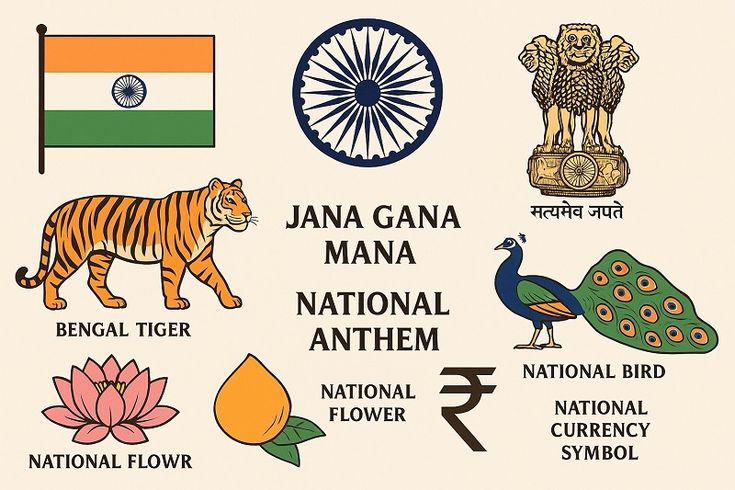National Symbols
- 1. National Flag of India (Tiranga)
- 2. National Emblem of India
- 3. National Anthem – “Jana Gana Mana”
- 4. National Song – “Vande Mataram”
- 5. National Animal – Bengal Tiger (Panthera tigris tigris)
- 6. National Bird – Indian Peacock (Pavo cristatus)
- 7. National Flower – Lotus (Nelumbo nucifera)
- 8. National Tree – Banyan (Ficus benghalensis)
- 9. National Fruit – Mango (Mangifera indica)
- 10. National River – Ganga
- 11. National Currency – Indian Rupee (₹)
India’s National Symbols, covering their history, significance, and societal importance:
1. National Flag of India (Tiranga)
Description: A horizontal tricolor of saffron, white, and green with the Ashoka Chakra (24-spoke navy blue wheel) in the center.
Adopted: 22nd July 1947
Significance:
Saffron: Courage and sacrifice
White: Peace and truth
Green: Prosperity and growth
Ashoka Chakra: Dharma (righteousness) and progress
Impact: Symbolizes unity in diversity and India’s struggle for freedom.
2. National Emblem of India
Description: An adaptation of the Lion Capital of Ashoka at Sarnath with four lions standing back to back.
Adopted: 26th January 1950
Significance:
Represents power, courage, pride, and confidence.
Features also include a horse, bull, Dharma Chakra, and “Satyameva Jayate” (Truth Alone Triumphs).
Impact: Used on currency, official documents, and government communication, symbolizing authority and governance.
3. National Anthem – “Jana Gana Mana”
Written by: Rabindranath Tagore
Adopted: 24th January 1950
Significance: Inspires patriotism, unity, and love for the nation.
Impact: Sung at official functions, sports events, and schools, creating national pride.
4. National Song – “Vande Mataram”
Written by: Bankim Chandra Chatterjee
Significance: Symbol of resistance against colonial rule and devotion to the motherland.
Impact: Recited during cultural events and national celebrations.
5. National Animal – Bengal Tiger (Panthera tigris tigris)
Significance: Strength, agility, and grace.
Impact: Represents India’s wildlife heritage and conservation priorities (Project Tiger).
6. National Bird – Indian Peacock (Pavo cristatus)
Significance: Beauty, elegance, and pride.
Impact: Appears in art, folklore, and cultural symbolism.
7. National Flower – Lotus (Nelumbo nucifera)
Significance: Purity, spiritual awakening, and resilience.
Impact: Frequently used in religious and cultural contexts, also in state symbols.
8. National Tree – Banyan (Ficus benghalensis)
Significance: Longevity, unity, and shelter.
Impact: Symbolizes Indian heritage, community, and wisdom.
9. National Fruit – Mango (Mangifera indica)
Significance: Sweetness, prosperity, and cultural pride.
Impact: Cultivated widely, used in festivals, cuisine, and rituals.
10. National River – Ganga
Significance: Purity, life-giving, and spirituality.
Impact: Supports millions in agriculture, daily life, and religious practices.
11. National Currency – Indian Rupee (₹)
Symbol: ₹
Significance: Represents economic sovereignty and national identity.
Impact: Used in trade, commerce, and daily financial transactions.
Conclusion
India’s national symbols reflect the country’s rich heritage, diversity, and values. From the flag and emblem that inspire patriotism, to the Bengal tiger and peacock representing natural beauty and strength, each symbol carries deep meaning. They unify citizens, instill pride, and preserve India’s cultural and ecological legacy for future generations.









magnificent post, very informative. I wonder why the other experts of this sector don’t notice this. You should continue your writing. I am sure, you’ve a great readers’ base already!